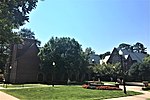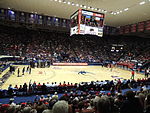Rocky Mills
Central Virginia Registered Historic Place stubsColonial Revival architecture in VirginiaHistoric American Buildings Survey in VirginiaHouses completed in 1750Houses completed in 1928 ... and 5 more
Houses in Hanover County, VirginiaHouses in Henrico County, VirginiaHouses on the National Register of Historic Places in VirginiaNational Register of Historic Places in Henrico County, VirginiaRelocated buildings and structures in Virginia

Rocky Mills, built c. 1750, was a Georgian mansion in Hanover County, Virginia. Disassembled and relocated about 21 miles to Henrico County, Virginia in 1928, it was reassembled and expanded by architect H. Louis Duhring, Jr. The woodwork and paneling of its rooms is particularly fine. Now renamed "Fairfield," the property, including four contributing buildings, was listed on the National Register of Historic Places in 2002.
Excerpt from the Wikipedia article Rocky Mills (License: CC BY-SA 3.0, Authors, Images).Rocky Mills
Ross Road,
Geographical coordinates (GPS) Address Nearby Places Show on map
Geographical coordinates (GPS)
| Latitude | Longitude |
|---|---|
| N 37.565555555556 ° | E -77.553888888889 ° |
Address
Ross Road 211
23229
Virginia, United States
Open on Google Maps








